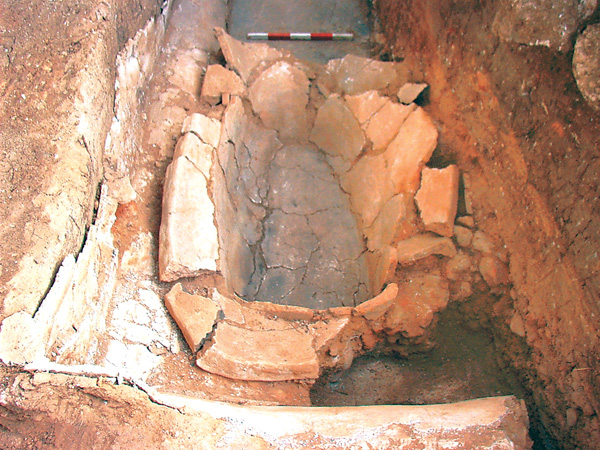Strata: Assyrians in Ashdod, Judith Sudilovsky, BAR 30:06, Nov-Dec 2004.
 Bible and Beyond
Bible and Beyond
Palace Uncovered Near Israel’s Coast
Click here to view the original article.
The Israel Antiquities Authority (IAA) has uncovered what may be the administrative palace of the representative of Assyrian ruler King Sargon II (721–705 B.C.) in Ashdod. IAA archaeologists Elena Kogan-Zahavi and Pirhiya Nahshoni uncovered the palace when the IAA was called in after remains were found during work on the Ashdod light-rail project.
After excavating several areas, Kogan-Zahavi and Nahshoni found the palace and immediately identified it as Assyrian because of the distinctive way it was built, which was very different from local building practices. “The whole building was made from square mudbricks, which was typical for Mesopotamian construction,” Kogan-Zahavi said, whereas in nearby Tel Ashdod, the site of ancient Ashdod, “all the buildings are made from rectangular bricks.”
The archaeologists have no doubt the complex is a palace. According to Kogan-Zahavi, the new find has massive 10-foot-wide walls, and the entire structure, which she estimates originally measured 400 feet square, is built on a podium that dramatically elevated it about 6 feet above the surrounding landscape. Kogan-Zahavi observed that these features are typical of Assyrian public buildings. “It was an immense structure; they wanted everyone to see it,” she said. “The podium is built from red brick. It is very beautiful; very impressive.” Dating the palaces was also easy. As Kogan-Zahavi explained, “We know that in 712 B.C. Ashdod revolted and that Sargon sent in an army to quell the rebellion and destroyed Ashdod, installing his own governor for the city, so we know the exact period the palace was built.”
One of the more significant finds uncovered in this season’s dig was two bathing rooms—one with a stone bathtub and a clay bathtub, and the other with a clay bathtub. According to Kogan-Zahavi, the excavators initally thought the bathtubs were coffins, since objects of this kind had been found previously in Assyrian burials. But these tubs were different. “This is the first time we have found them within the context of a bathroom … we know they were used as bathtubs because there were no bones inside, and they were found in rooms with special water-proof plastered areas,” Kogan-Zahavi said. “Also, coffins are usually found underground.” Kogan-Zahavi admitted that her findings are “very preliminary,” and that it is strange that the same object would be used for burial and for bathing. “We have to look into this,” she said.
The archaeologists know that the palace itself was destroyed sometime in the seventh century B.C., although they do not know by whom. Evidence suggests that subsequent occupiers used the site for different purposes, as indicated by the remains of non-monumental buildings, ceramics and pieces of statues inside a favissa, the part of a Persian temple where damaged cultic statues were disposed of. “This indicates to us that there is also a Persian temple here, which we have not found,” Kogan-Zahavi said.
According to Kogan-Zahavi, the lack of time and money prevented them from taking anything more than a quick peek at the site. However, she is confident that real treasure awaits; she believes that there is a good chance the palace’s administrative archives remain to be unearthed. “The archives are what everyone is eager to find,” she said, noting that the conditions at the site are ripe for such a discovery. “Here,” she explained, “sat the governor of Ashdod, who surely maintained an archive of all of his correspondence within the region. The correspondence was most likely written either on stone or clay tablets and it is highly likely that, because of the fire, there was no time to remove the tablets from where they were stored inside the palace.” Kogan-Zahavi hopes that some university will take on the excavation. “We already know where the palace is—they just have to come and find the goodies.”
Meanwhile, Ashdod’s light-rail train is looking for a new route.



